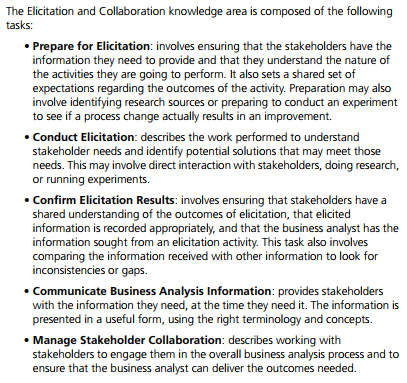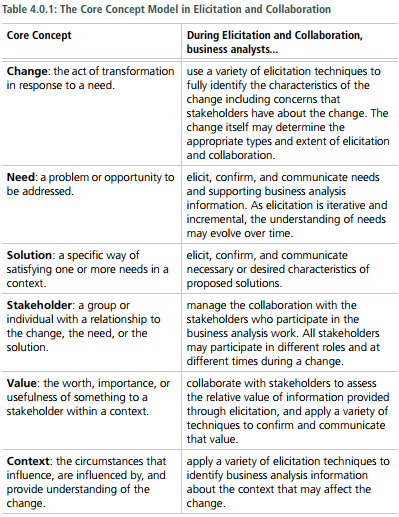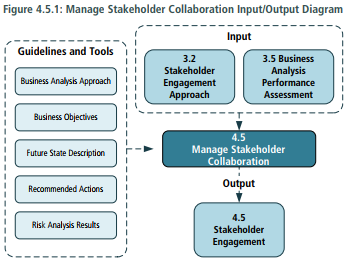Elicitation and Collaboration
Chapter 4. Elicitation and Collaboration


Each Task in the BABOK Guide is presented in the following format:
- Purpose >
- Description >
- Inputs >
- Elements >
- Guidelines / Tools >
- Techniques >
- Stakeholders >
- Outputs >
1. Prepare for Elicitation
- Purpose > The purpose of Prepare for Elicitation is to understand the scope of the elicitation activity, select appropriate techniques, and plan for (or procure) appropriate supporting material and resource.
- Description: Business analysts prepare for elicitation by defining the desired outcomes of the activity, considering the stakeholders involved and the goals of the initiative.
- Inputs > Needs > Stakeholder Engagement Approach
- Elements > Understand the Scope of Elicitation > Select Elicitation Techniques > Set up Logistics > Secure Supporting Material > Prepare Stakeholders
- Guidelines / Tools > Business Analysis Approach > Business Objectivies > Existing Business Analysis Information > Potential Value
- Techniques > Brainstorming > Data Mining > Document Analysis > Estimation > Interviews > Mind Mapping > Risk Analysis and Management > Stakeholder List, Map, or Personas
- Stakeholders > Domain Subject Matter Expert > Project Manager > Sponsor
- Outputs > Elicitation Activity Plan: used for each elicitation activity. It includes logistics, scope of elicitation activity, selected techniques, and supporting materials.
2. Conduct Elicitation
- Purpose > The purpose of Conduct Elicitaion is to draw out, explore, and identify information relevant to the change.
- Description > Collaboration > Research > Experiments
- Inputs > Elicitation Activity Plan
- Elements > Guide Elicitation Activity > Capture Elicitation Outcomes
- Guidelines / Tools > Business Analysis Approach > Existing Business Analysis Information > Stakeholder Engagement Approach > Supporting Materials.
- Techniques > Benchmarking and Market Analysis > Brainstorming > Business Rules Analysis > Collaborative Games > Concept Modelling > Data Mining > Data Modelling > Document Analysis > Focus Groups > Interface Analysis > Interviews > Mind Mapping > Observation > Process Analysis > Process Modelling > Prototyping > Survey or Questionnaire > Workshops
- Stakeholders > Customer > Domain Subject Matter Expert > End User > Implementation Subject Matter Expert > Sponsor > Any Stakeholders
- Outputs > Elicitaton Results (unconfirmed): captured information in a format that is specific to the elicitation activity.
3. Confirm Elicitation Results
- Purpose > The purpose of Confirm Elicitation Results is to check the information gathered during an elicitation session for accuracy and consistancy with other information.
- Description: Elicited information is comformed to identify any problemand resolve them before resource are committed to using the information. This review may discover errors, omissions, conflicts, and ambiguity.
- Inputs > Elicitation Results (unconfirmed) >
- Elements > Compare Elicitation Results Against Source Information > Compare Elicitation Results Against Other Elicitation Results
- Guidelines / Tools > Elicitation Activity Plan > Existing Business Analysis Information
- Techniques > Document Analysis > Interviews > Reviews > Workshops
- Stakeholders > Domain Subject Matter Experts > Any Stakeholder.
- Outputs > Elicitation Results (confirmed): intergrated output that the business analyst and other stakeholders agree correctly reflects captured information and confirms that it is relevant and useful as an input to further work.
4. Communicate Business Analysis Information
- Purpose > The purpose of Communicate Busiiness Analysis Information is to ensure stakeholders have a shared understanding of business analysis information.
- Description: Business analysts must communicate appropriate to stakeholders the right time in formats that meet their needs. Consideration is given to expressing the information in language, tone, and style that is appropriate to the audience.
- Inputs > Business Analysis Information > Stakeholder Engagement Approach
- Elements > Determine Objectives and Format of Communicaton (formal documentation / informal documentation/ presentations) > Communicate Business Analysis Package (group collaboraton/ individual collaboration/ E-mail or other non-verbal methods)
- Guidelines / Tools > Business Analysis Approach > Information Mangement Approach
- Techniques > Interviews > Reviews > Workshops
- Stakeholders > End User > Customer > Domain Subject Matter Expert > Imlementaion Subject Matter Expert > Tester > Any Stakeholder
- Outputs > Business Analysis Information (communicated): business analysis information is considered communicate when the target sakeholders have reached an understanding of its content and implications.
5. Manage Stakeholder Collaboration
- Purpose > The purpose of Manage Stakeholder Collaboraton is to encourage to work towards a common goal.
- Description: Business analysis work lends itself to many opportunities group of stakeholders on the business analysis work products. Stakeholders hold various degrees of influence and authority over the approval of work products, and are also an important source of needsm constraints, and assumptions. As the business analysis work progresses, the business analyst identifies stakeholders, confirms their roles, and communicates with them to ensure that the right stakeholders participate at the right times and in the appropriate roles.
- Inputs > Stakeholder Engagement Approach> Business Analysis Performance Assessment

- Elements > Gain Agreement on Commitments > Monitor Stakeholder Engagement > Collaboration
- Guidelines / Tools > Business Analysis Approach > Business Objectives > Future State Description > Recommended Actions > Risk Analysis Results
- Techniques > Collaborative Games > Lessons Learned > Risk Analysis and Management > Stakeholder List, Map, or Personas
- Stakeholders > All Stakeholders
- Outputs > Stakeholder Engagement: Willingness from stakeholders to engage in business analysis activities and interact with the business analyst when necessary.